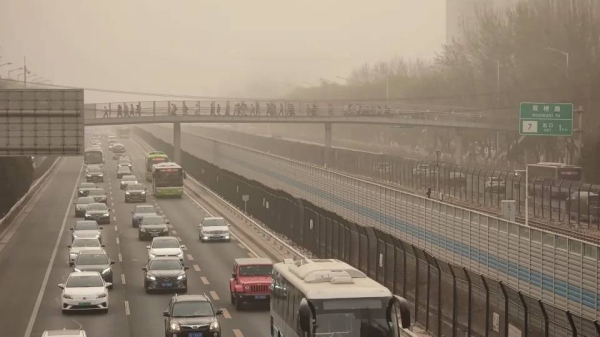
A massive sandstorm has combined with already high air pollution to turn the skies in Beijing an eerie orange, and send some air quality measurements off the charts.
Air quality indexes recorded a “hazardous” 999 rating on Monday as commuters travelled to work through the thick, dark air across China’s capital and further west.
Chinese meteorological authorities issued its second highest alert level shortly before 7.30am, staying in place until midday. A broader warning for sand and dust blowing in from the western desert regions was put in effect until Tuesday morning.
When Beijing’s realtime air quality index (AQI) showed a reading of 999, Tokyo recorded 42, Sydney 17 and New York 26. Hong Kong and Taiwan recorded “moderate” readings of 66 and 87, respectively.
Levels of PM2.5, the small air pollution particles that infiltrate the lungs, were recorded above 600 micrograms in many parts of the city, reaching a 24-hour average of 200 before midday. The World Health Organization recommends average daily concentrations of just 25.
The sandstorm blown in from the desert stretching into Inner Mongolia saw concentrations of the larger PM10 particles surpass 8,000 micrograms according to state media.
State media reported at least 341 people were reported missing in neighbouring Mongolia, which was also hit by sandstorms, and flights were grounded out of Hohhot in inner Mongolia.
On social media several people shared screenshots of other air quality indexes showed readings of more than 9,000, officially “beyond index”.
Some residents in Ningxia, in China’s west, said they woke up in the middle of the night feeling as though they couldn’t breathe. One commenter on Weibo joked that they felt like they needed to learn how to ride a camel.
Sandstorms are relatively common at this time of year, and usually attributed to winds blowing across the Gobi desert, but long-term residents said they had not seen one of this severity in years.
Large-scale deforestation is also considered a factor in the spring dust storms, and China has been trying to reforest and restore the ecology of the region in order to limit how much sand is blown into the capital.
Beijing has planted a “great green wall” of trees to trap incoming dust, and tried to create air corridors that channel the wind and allow sand and other pollutants to pass through more quickly.
Beijing and surrounding regions have been suffering from high levels of pollution in recent weeks, with the city shrouded in smog during the national session of parliament which began earlier this month.
Tangshan, China’s top steelmaking city and a major source of pollution in Beijing and Hebei, said on Saturday it would punish local enterprises for failing to carry out emergency anti-smog measures.












